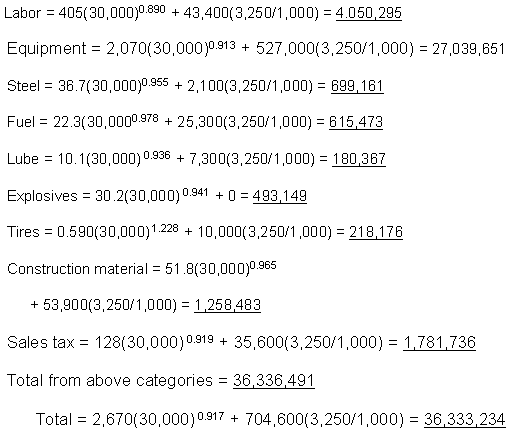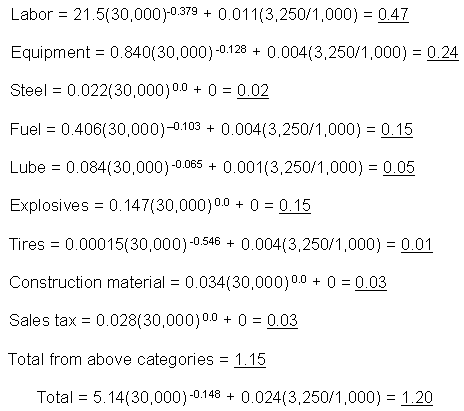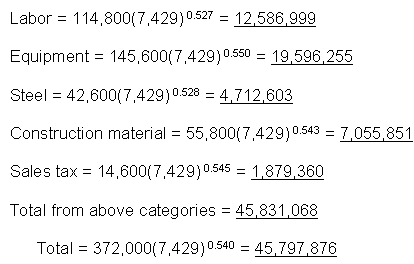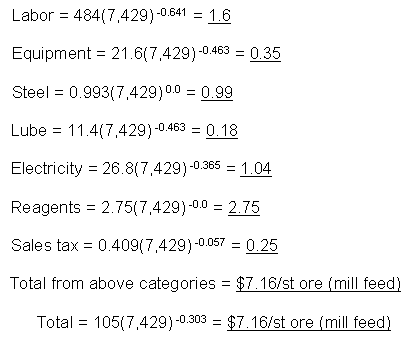
APPENDIX C. EXAMPLE PROBLEM, OPEN PIT MINE, CIP MILL
The following example demonstrates how to apply the large open pit mine, CIP mill, and tailings pond equations. An example of mine life, capacity, and underground equations is in appendix D.
Assume a SR of 2:1, 10,000 st/d ore, 20,000 st/d waste, for a total of 30.000 st/d of material mined per day, 260 d/yr. Milling is 350 d/yr, so the feed rate to the mill is 10,000(260/350) = 7 429 st/d.
LARGE OPEN PIT MINE
For a production rate of 30,000 st/d, use table 7 or 9. Table 9 will be used to demonstrate the use of haulage factors in the cost equations.
Haulage factor: The following two approaches can be used by an evaluator to account for haulage distances. The second approach will be used for the example problem.
(1) Assume the average haul distance for ore and waste is the same as the base case used for the model, in which case use the base-case cost equations in table 7 (table 6 for small open pits). This is the simplest method.
(2) Given an average haul distance, compare to the base-case distance calculated from equation 101 (equation 9 for small open pits). Subtract the base-case distance from the given haul distance to find f (average haulage distance in excess of base case) and calculate the costs using table 9 (table 8 for small open pits). This situation is demonstrated in equations 11 and 12 in the open-pit haulage adjustment factor description earlier in this report, in addition to the following example of calculating f.
The first step is to determine the average haul distance that was the basis for the cost equations. Since the large open pit model will be used, equation 10 is referred to for determining the average haul distance in the base case:
large open pit: av. haul distance, ore and waste (in ft)

Assuming a given average haul distance of 9,000 ft, then f = 9,000 - 5,750 = 3.250. Insert 3,250 for f in each of the equations in table 9 to calculate the costs.
Equation numbers without a letter prefix (A-, B-, etc.) refer to equations in the main text.
Capital cost estimate:

Comparison of totals using individual cost categories vs. total cost equation: 36,336,491/36,333,234 = 1.000, 0.0% difference due to rounding in regression equations.
Operating cost estimate:

Comparison of totals using individual cost categories vs. total cost equation: 1.15/1.20 = 0.96, 4% difference due to rounding in regression equations.
Using the total from the individual categories, $1.15/st of material moved, and using the SR of 2:1, the operating cost in dollars per st ore = 1.15 x 3 = $3.45 st ore. Three short tons of material must be moved to produce 1 st of ore, so the operating cost per short ton of material must be multiplied by three for a 2:1 SR.
CIP MILL
As mentioned above, milling is 350 d/yr, so the feed
rate to the mill, X = 10,000(260/350) = 7,429 st/d
Capital cost estimate:

Comparison of totals using individual cost categories vs. total cost equation: 45,831,068/45,797,876 = 1.001, 0.1% difference due to rounding in regression equations.
Operating cost estimate:

Comparison of totals using individual cost categories vs. total cost equation: 7.16/7.05 = 1.016, 1.6% difference due to rounding in regression equations.
TAILINGS POND
The tailings pond costs are from table 17 and include the cost of installing a liner. Assume the area required (A) for the pond is 130 acres, with 4,700 ft of impoundment dam (L) to be constructed. The equations below from table 17 include the costs: tails pond + dam + liner. Cost equations for tailings ponds cover capital costs only. The minimal amount of costs associated with operating a tailings pond are considered included in the mill operating costs.
Capital cost estimate:
Labor = [30,200 + 502(A)] + 45(L) + 9,500(A) = [30,200 + 502(130)] + 45(4,700) + 9,500(A) = 1,541,960
Equipment = 502(A) + 45(L) + 0 = 502(130) + 45(4,700) = 276,760
Steel = 109,200 + 0 + 5(L) = 109,200 + 5(4,700) = 132,700
Fuel = 601(A) + 55(L) + 0 = 601(130) + 55(4,700) = 336,630
Lube = 148(A) + 13(L) + 0 = 148(130) + 13(4,700) = 80,340
Construction material = 0 + 0 + 24,800(A) = 24,800(130) = 3,224,000
Sales tax = [6,600 + 30(A)] + 3(L) + 1,490(A) = [6,600 + 30(130)] + 3(4,700) + 1,490(130) = 218,300
Total from above categories = 5,810,690
Total = [146,000 + 1,783(A)] + 161(L) + [5(L) + 35,790(A)] = [146,000 + 1,783(130)] + 161(4,700) + [5(4,700) + 35,790(130)] = 377,790 + 756,700 + 4,676,200 = 5,810,690
Comparison of totals using individual cost categories vs. total cost equation: 5,810,690/5,810,690 = 1.000, 0% difference. Note the large amount of the cost attributed to the liner: 4,676,200, which is 80% of the total capital cost for the tailings pond.